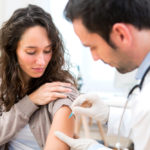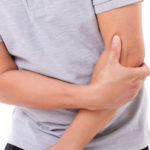Injuries are painful and annoying but usually heal after a few days. No big deal. But the Koebner phenomenon is different. Even small injuries like cuts or simple pressure points can cause painful psoriasis. This little-researched symptom affects many psoriasis sufferers and is also suspected of triggering psoriasis in healthy skin.
What is the Koebner phenomenon?
The Koebner phenomenon (also called isomorphic irritation) is a rare reaction of the skin to mechanical, thermal or other irritation. As a reaction to the irritation of the skin, psoriasis forms around the wound. This symptom mainly affects people who already have psoriasis. However, it can also occur with completely healthy skin. The phenomenon is named after the dermatologist Heinrich Köbner, who first described it in 1872. Since the discovery of this phenomenon, many new findings have been made, but the occurrence of the phenomenon cannot yet be fully explained.
Causes
So far, there is no conclusive explanation as to why the skin of some affected persons reacts to injuries. The symptoms manifest themselves in very different ways. The triggering factors are also very individual. It is therefore difficult to identify clear factors as the cause.
The possible causes include:
- Cuts (this also includes injuries caused by shaving)
- Allergic reactions
- Infections
- Insect bites
- Burns (including sunburn)
- Superficial injuries of the skin (e.g. abrasion)
- Bruises
- Pressure points (e.g. pressure on temples from glasses, tight clothing)
- Diaper rash
- Eczema
- Warts
- Dermatitis
Some people also report that scales have formed as a result of tattoos, vaccinations or acupuncture treatments.
There also seems to be a connection between the weather and the Koebner phenomenon. In the cold winter months, it occurs noticeably less often than in the warm summer months.
Studies suggest that both the immune system and hormones play a role in the occurrence of the Koebner phenomenon.
Who is affected by the Koebner phenomenon?
In principle, the Koebner phenomenon can affect anyone. Even people who have never had skin problems can develop symptoms. However, these cases are rare. People who have psoriasis have a significantly higher risk. However, it is particularly common in cases where psoriasis has been diagnosed at a very young age. People with white spot disease (vitiligo) or an increased incidence of warts also belong to the risk group.
The connection between the Koebner phenomenon and psoriasis
Psoriasis is a chronic inflammatory disease of the skin. The skin divides far too quickly, resulting in itchy, inflamed and painful psoriasis.
There are three relevant connections between psoriasis and the Koebner phenomenon:
The phenomenon mainly affects psoriasis patients
Although the general public has often never heard of this phenomenon, it is a bitter reality for many psoriasis sufferers. Research shows that almost every fourth patient has to struggle with the Koebner phenomenon. People who have been diagnosed with psoriasis in their childhood are particularly often affected.
It can cause psoriasis
Although the phenomenon almost always affects people who already have psoriasis, it can also trigger psoriasis. Psoriasis is an autoimmune disease of the immune system and is often caused by stress, medication, an unhealthy lifestyle, hormonal fluctuations and environmental influences. In rare cases, however, injury to the skin is the trigger for psoriasis. In these cases, one speaks of the Koebner phenomenon.
The symptoms are atypical
In many psoriasis sufferers, the increased psoriasis typically occurs on the elbows, knees, hands, feet and scalp. In the Koebner phenomenon, however, a new psoriatic focus (plaques) forms directly at the sore spot.
How is the Koebner phenomenon diagnosed?
Diagnosing the Koebner phenomenon is often difficult. Because the causes are so varied, it is often not possible to establish a clear connection. In some cases, it also takes several weeks before the symptoms appear after the stimulus.
If you suspect that you are experiencing the symptoms, you should consult your doctor.
Treatment
Basically, the scales caused by the Koebner phenomenon are treated just like “normal” psoriatic skin. Depending on the reaction and severity of the symptoms, different healing approaches help.
Possibilities for treatment:
- Creams and lotions
- Psoriasis medication
- Biologics
- Light therapy
- Oils such as almond oil, evening primrose oil or black cumin oil
- Home remedies such as chamomile cream or baths
- Food supplements such as turmeric or omega 3 fatty acids
For the most success in healing the skin, you should consult your doctor.
Can the Koebner phenomenon be prevented?
Unfortunately, there is no guarantee that symptoms can be avoided.
However, the immune system and the body in general can be helped by staying healthy. This can reduce the risk of the Koebner phenomenon occurring.
These three pillars help avoid having symptoms.
Keeping the skin healthy
Sensitive psoriatic skin in particular must be cared for properly. This means treating psoriasis correctly and providing your skin with a lot of care. The healthier the skin is, the less likely or severe the symptoms will be.
A healthy lifestyle
A strong immune system and a healthy body support the skin from within. Nutrient-rich nutrition, regular exercise and sufficient sleep are the core pillars of a healthy lifestyle.
Knowing and reducing trigger factors
The better you know your body, the better you can reduce trigger factors. Too much stress, certain foods, injuries and infections and being overweight can promote the onset of the Koebner phenomenon. For many affected people, it helps to stop smoking and reduce alcohol consumption.
A little-known phenomenon with a fierce effect
Even though the interrelationships of the phenomenon are still not fully understood, it is everyday life for many psoriasis sufferers. Even small wounds can trigger or aggravate a psoriasis attack. With careful skincare, the right medication and a balanced lifestyle, the risk can be reduced.
Are you affected by the Koebner phenomenon?
What helps you? Tell us about it in the comments.
FAQ
What is the Koebner phenomenon?
The Koebner phenomenon (also known as isomorphic irritation) is an excessive reaction of the skin to mechanical, thermal or other irritation. As the skin is irritated, psoriasis forms around the wound. The phenomenon mainly affects psoriasis sufferers, but can also occur in healthy skin.
Does the Koebner phenomenon trigger psoriasis?
Yes, the Koebner phenomenon can trigger psoriasis. In addition, people affected by psoriasis suffer from the phenomenon many times more frequently than people with healthy skin. The connections have not yet been fully clarified, but the overactive immune system of psoriasis patients seems to play a role. Good skincare, the right medication and a healthy lifestyle reduce the risk of contracting the phenomenon.
How is the Koebner phenomenon treated?
The scales resulting from the injury are treated like normal psoriasis. Depending on the strength of the reaction and the symptoms, creams, medications, biologicals, household remedies or alternative therapies can help. A healthy lifestyle supports the healing process. The treatment should always be discussed with a doctor.
Find all the sources
Heinrich Köbner und der “isomorphe Reizeffekt”,Norbert Kuner, W. Hartschuh, B. Khan-Durani, Der Hautarzt, Springer-Verlag, 2003
Wikipedia, via https://de.wikipedia.org/wiki/Isomorpher_Reizeffekt (January 2020)
Gesundheitsberichterstattung des Bundes, Heft 11 SchuppenflechteRobert Koch-Institut , 2002, via https://edoc.rki.de/bitstream/handle/176904/3160/220ShwcFDLtSs_62.pdf?sequence=1 (January 2020)
Schuppenflechte, Was Sie schon immer über Psoriasis wissen wollten,Mrowietz, G. Schmid-Ott, S. Karger Verlag, 2017

Bernd is one of the founders of Simply Psoriasis. He has been suffering from psoriasis for more than 20 years, but sees the chronic skin disease with more composure than a few years ago (which was a hard work). Nevertheless, he is very keen to make psoriasis easier and more socially accepted.









Last Comments